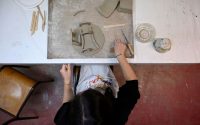Beeple: China’s Deji Art Museum Seems Like ‘Great Stewards’ For S.2122 Sculpture
Nanjing, China’s Deji Art Museum has acquired Beeple’s sculpture S.2122 (2023), the artist confirmed with ARTnews Wednesday.
“It was a crazy, exciting time [at Art Basel Hong Kong],” Beeple said in a recent interview. “We were talking to the Museum all week because they really wanted to understand the piece, its motivations and capabilities. They just seem like great stewards for this piece, so genuinely interested in this new form of storytelling.”
The work was sold by LGDR gallery at Art Basel Hong Kong for a reported $9 million, Baer Faxt reported Sunday. However, take that price with a grain of salt; Artnet‘s Katya Kazakina reported last May that Dominique Lévy and Brett Gorvy fudged the sale price for a Joan Mitchell supposedly sold at Art Basel Hong Kong in 2021. The gallery said it could not confirm the sale price of S.2122 as per their contract with the museum.
The sculpture is the sister piece to Human One (2021), which was bought by venture capitalist Ryan Zurrer at Christie’s for $29 million at the peak of the NFT craze. Human One is currently on view at the M+ Museum in Hong Kong.
The sculptures are similar in appearance and function: both are tall, rectangular cubes with steel fittings and panels of screen fixed to each side. Beeple’s 3D animations play out on this screen, creating the illusion that the box contains a slice of the sci-fi worlds he often depicts in his illustrative work. Human One “contains” an astronaut who slowly paces through different landscapes and S.2122 represents a building complex from the future, complete with hovering drones and mushrooms, floating in a sea of water.
The particular draw of these pieces is that Beeple, the artist name of Mike Winkelmann, has control over the design being shown in the sculpture and can change it at will thanks to blockchain technology. The changes that Beeple makes to Human One are more ad-hoc, whereas he has a set plan for how he will be adjusting S.2122 while it resides in the museum. The idea is to have the water rise about a quarter of the way up the tank every 5 years, with the building and its inhabitants completely submerged in 25 years time.
“But the people will live, they will find a way to live underwater,” said Beeple, explaining that, in this climate change–themed work, he wanted to illustrate the seriousness of the crisis and his belief that humans will survive and adapt to planetary chaos.
Though Beeple made it into the annals of art history when he sold his NFT Everydays: The First 5,000 Days for $69 million at a Christie’s auction in 2021 (making him the third-most expensive living artist in the world), this marks the first time a museum has acquired his work. In fact, it’s the first time his work was brought to an art fair. While he was waiting for this honor, however, Beeple built his own museum, a studio and digital art gallery located in Charleston, South Carolina, named Beeple Studios, which he opened earlier this month.
While LGDR’s Brett Gorvy told ARTnews that he wasn’t particularly supportive of NFTs during the 2021 boom, he saw Beeple’s Human One at Christie’s and was hooked by the interloping artist. When he heard that Beeple was creating his third major work — after Everydays and Human One — Gorvy knew he wanted to get LGDR involved.
“I went to Christies and saw this magical box, what was clearly the next step of what a sculpture could be,” said Gorvy, who mentioned that his team often referred to S.2122 as “City Box.”
Gorvy credited Christie’s for “single-handedly” creating a market for NFTs with the Everydays sale and said he wondered if LGDR could use an art fair to introduce Beeple to audiences in Asia and to institutions, but only an Asian one.
“American and European museums are burdened by what they already have,” said Gorvy. “Whereas Asian and especially Chinese institutions like Deji, which are newer and private, have a very contemporary viewpoint of art history, similarly to institutions in the Middle East.”


